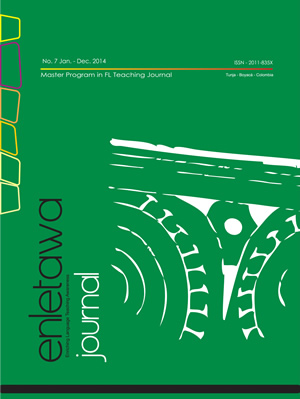Exploring critical literacy skills in a literature and culture class

Abstract
Critical literacy is a concept that has gained a substantial meaning in literacy fields. It offers a rich field to explore since it goes beyond the simple perception of ability or a skill. In that sense, this paper aims to present the results of a research study based on identifying and describing how critical literacy skills emerged as students of the course in Literature and Culture of Englishspeaking countries, reflected, questioned
and inquired on culture and identity issues that are involved in different literary texts. As conclusion, it was possible to establish thatDialectical notebooks or double entry journals are useful to guide students into
more reflective and analytical reading processes where they are able to confront their own realities with the texts they read.
References
- Anzaldúa, G. (2007). Borderlands: La Frontera: The new Mestiza. San
- Francisco: Aunt Lute Books.
- Auerbach, E. (1992). Making meaning, making change: Participatory curriculum development for adult ESL literacy. McHenry, IL and Washington, DC: Delta Systems and Center for Applied Linguistics.
- Bhabha, H. (2002). Interrogating Identity. Frantz Fanon and the Postcolonial Prerogative, in Location of Culture. London and New York: Routledge.
- Brown , K. (1999). Developing critical literacy. Sydney, NSW,Australia: National Centre for English Language Teaching and Research,Macquarie University.
- Burns, A. (2010). Doing Action Research in English Language Teaching:AGuide for Practitioners. NewYork, NY: Routledge
- Cabeza de Vaca, Á. (1907). The Narrative of Alvar Nunez Cabeza de Vaca. Edited by F. W. Hodge. New York: Scribner’s.
- Calkins, M. (1986). Art of Teaching Writing. Portsmouth, NH: Heinemann.
- Collins, J & Blot, R. (2003). Literacy and Literacies. West Nyack, NY, USA: Cambridge University Press. Retrieved from:http://site.ebrary.com/lib/bibliotecauptc/Doc?id=10069924&ppg=172.
- Denzin, N. (1970). The Research Act in Sociology.Chicago:Aldine.
- Ewing, R., Miller, C. & Saxton, J. (2008) ‘Drama and contemporary picture books in the middle years’ in J. Hughes, M. Anderson & J. Manuel (eds.), Drama Teaching in English: Imagination, Action and Engagement, pp. 121–135, Oxford University Press, Melbourne.
- Ferreiro, E. (2003). Past and Present of the verbs to Read and to Write. Toronto: Groundwood Books
- Freire, P. (1970). Pedagogy of the oppressed. New York: Continuum.
- Hammond, J., Burns,A., Joyce, H., Brosnan, D. & Gerot, L. (1992).English for social purposes. Sydney: NCELTR
- Hefferman, L & Lewison, M. (2000). Making real-world issues our business: critical literacy in a third grade classroom. Primary voices K-6, 9, 2, 15-21.
- Kramsch, C. (1998). Language and Culture. Oxford University Press. Oxford
- Kumaravadivelu, B. (2006). Understanding language teaching: From method to postmethod. Mahwah, NJ.: Lawrence Erlbaum.
- Lohrey, A. (1998). Critical literacy: A professional development resource.
- Melbourne, Australia: Language Australia.
- Merriam, S. (1991). Case Study Research in Education:AqualitativeApproach. San Francisco. Oxford: Jossey-Bass
- Publishers.
- Mingus, Charles. (1998). Beneath the Underdog. London: Canongate Books.
- Momaday, N. (1975).The Writer Warrior. Retrieved from: http://www.achievement. org/autodoc/page/mom0int-3
- Ortiz, F. (1995), Cuban Counter point: Tobacco and Sugar, Durham, NC: Duke University Press
- Ortiz, S. (1992).Woven Stone.Tucson: University of Arizona press.
- Perdomo,M. (2001).An approach to making students autonomous readers of the English Language.Profile, 2, 1, (pp. 57- 58).
- Robinson, E., & Robinson, S. (2003). What does it mean? Discourse, Text, Culture: An Introduction. Sydney: McGraw-Hill Book Company
- Tapahonso, L. (1987). Who were You? Retrieved fromhttp://www.hanksville.org/voyage/poems/drunk/drunk4.html
- Wallace, C. (1992). Critical literacy awareness in the EFL classroom. In. N Fairclough (ed). Critical language awareness. Harlow: Longman.